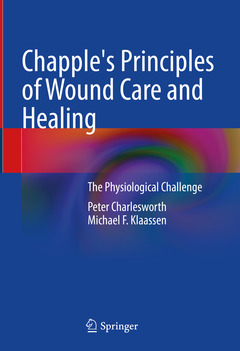Description
Chapple's Principles of Wound Care and Healing, 1st ed. 2024
The Physiological Challenge
Authors: Charlesworth Peter, Klaassen Michael F.
Language: English
Subjects for Chapple's Principles of Wound Care and Healing:
139 p. · 17.8x25.4 cm · Hardback
Description
/li>Contents
/li>Biography
/li>Comment
/li>
This book is a tribute to Dr Joan Chapple CNZM FRACS, who qualified as New Zealand's first formally trained female plastic surgeon in the late 1950s and practised as a plastic and hand surgeon in Auckland, New Zealand for over 38 years. She was selected for surgical training by the late Sir William Manchester, who started the Middlemore Plastic Surgery Unit in December 1950.
Joan was an original thinker and a pioneer in the fields of wound care and healing in her own right. She self-published ?The Management of Soft Tissue Injuries: Philosophy, Principles and Practice? in 1994, followed by her definitive ?Wound Care and Healing: The Physiological Challenge? in 2003.
Dr Chapple developed principles of a practical physiological approach to acute wounds that not only benefited their recovery and healing, but also demonstrably reduced the post-operative pain in her patients. She practised and taught these principles at her Soft Tissue Trauma Clinics, based at the Emergency Department of the then Auckland Public Hospital. She also lectured widely to nurses, medical students, general practitioners and surgeons.Joan Chapple?s primary hypotheses were: 1. Injury initiates a series of coordinated living responses. 2. Living cells need to be nurtured in a moist and non-toxic environment. 3. The speed and quality of recovery and repair after injury depends on the circulation. 4. The body recovers and heals with or without treatment, but never without circulation.
This republication of ?Chapple's Wound Care and Healing? comes with a modern orientation and includes expert commentaries, many of which confirm that Dr Chapple?s thinking, knowledge and surgical principles were ahead of their time. In addition, it contains a new chapter explaining her extraordinary life and career for a world readership.Joan Chapple remains an important virtual mentor to future generations of surgeons, nurses, emergency specialists and general practitioners.
Peter Charlesworth BSc, MBChB, FRACS
Peter graduated in the inaugural class of the University of Auckland School of Medicine in 1973 and subsequently undertook surgical training at Middlemore, Auckland, and Waikato hospitals. During this period, he had twelve months plastic surgical experience, which strongly influenced his later practise, but he naively declined an offer from Professor William Manchester to pursue a career in the field. In his final year of training, he was appointed Chief Surgical Resident, working under Professors E M Nansen and G L Hill. Following the completion of his surgical Fellowship he had a one year clinical and research appointment as a Lecturer in Surgery, University of Auckland. He then had three years overseas postgraduate training, completing a Fellowship in Surgical Metabolism at Columbia Presbyterian Medical Centre, New York, NY, a Vascular Fellowship at Massachusetts General Hospital, Boston, MA, and twelve months of General and Vascular surgery as Senior Registrar at St James’s University Hospital, Leeds, UK. On his return to New Zealand, he had a four-year appointment as a full-time General and Vascular surgeon at Middlemore Hospital, Auckland, followed by a number of part-time consultant appointments at other Auckland hospitals, eventually entering full-time private practice. After 30 years medical practice, for various reasons his passion for surgery died and he retired, retraining in Kent, UK, in the craft of antique furniture restoration a pursuit which he likens to plastic surgery with wood.
Michael Frederick Klaassen ONZN, MBChB, FRACS graduated MBChB from Otago University in 1980 and qualified as a plastic surgeon with the RACS in 1990 after a decade of surgical training, which included general surgery, orthopaedic surgery, surgical research and finally plastic and reconstructive surgery. He then spent 3 years gaining add
Presents an instinctive understanding of the role of circulation and reactive inflammation for common wounds
Illustrates a courageous ability to think outside the square and to respect science
Demonstrates insightful clinical observations of wound healing and physiology




